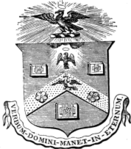Ave Maria Lane

Ave Maria Lane is a street in the City of London, to the west of St. Paul's Cathedral. It is the southern extension of Warwick Lane, between Amen Corner and Ludgate Hill. On the feastday of Corpus Christi, monks would say prayers in a procession to St. Paul's Cathedral. They set off from Paternoster Row chanting the Lord's Prayer (Pater noster being the opening words of the prayer in Latin). They would reach the final "Amen" as they turned the corner into Ave Maria Lane, after which they would chant Hail Mary (Ave Maria in Latin).Ave Maria Lane is home to the Grade I listed building Stationers' Hall, the livery hall of the Worshipful Company of Stationers and Newspaper Makers since 1670. The marathon route of the 2012 Summer Olympics passed along Ave Maria Lane.
Excerpt from the Wikipedia article Ave Maria Lane (License: CC BY-SA 3.0, Authors, Images).Ave Maria Lane
Stationers Hall Court, City of London
Geographical coordinates (GPS) Address Nearby Places Show on map
Geographical coordinates (GPS)
| Latitude | Longitude |
|---|---|
| N 51.5142 ° | E -0.1008 ° |
Address
Vidal Sassoon
Stationers Hall Court
EC4M 7AQ City of London
England, United Kingdom
Open on Google Maps










